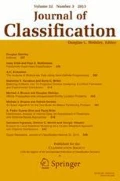References
AITCHISON, J., HABBEMA, J.D.F., and KAY, J.W. (1977), “A Critical Comparison of Two Methods of Statistical Discrimination,”Applied Statistics, 26, 15–25.
CRITCHLEY, F., and FORD, I. (1985), “Interval Estimation in Discrimination: The Multivariate Normal Equal Covariance Case,”Biometrika, 72, 109–116.
MORAN, M.A., and MURPHY, B.J. (1979), “A Closer Look at Two Alternative Methods of Statistical Discrimination,”Applied Statistics, 28, 223–232.
TIAO, G.C. (1967), Review ofInference and Disputed Authorship: The Federalist, Journal of the American Statistical Association, 62, 306–309.
JARDINE, N., and SIBSON, R. (1971),Mathematical Taxonomy, London: Wiley.
LEGENDRE, L. and LEGENDRE, P. (1979),Ecologie Numérique, Lere édition, Paris: Masson.
NIE, N.H., HALL, C.H., JENKINS, J.G., STEINBRENNER, K., and BRENT, D.H. (1975),SPSS-Statistical Package for the Social Sciences, 2nd edition, New York: McGraw-Hill.
PIMENTEL, R.A. (1979),Morphometrics. The Multivariate Analysis of Biological Data, Dubuque, Iowa: Kendall Hunt.
SAS (1982),SAS User's Guide & Statistics, 1982 edition, Cary, NC: SAS Institute.
SNEATH, P.H.A., and SOKAL, R.R. (1973),Numerical Taxonomy. The Principles and Practice of Numerical Classification, San Francisco: Freeman.
SOKAL, R.R., and CROVELLO, T.J. (1970), “The Biological Species Concept: A Critical Evaluation,”American Naturalist, 104, 127–153.
References
LEVINE, J.H. (1972a), “The Sphere of Influence,”American Sociological Research, 37, 14–27.
LEVINE, J.H. (1972b), “A Two-Parameter Model of Interaction in Father-Son Status Mobility,”Behavioral Science, 17, 455–465.
LEVINE, J.H. (1979), “Joint-Space Analysis of “Pick-any” Data: Analysis of Choices from an Unconstrained Set of Alternatives,”Psychometrika, 44, 85–92.
References
DAGANZO, C. (1980), “Optimal Sampling Strategies for Statistical Models with Discrete Dependent Variables,”Trans. Sci., 14.
LUCE, R.D. (1959),Individual Choice Behavior: A Theoretical Analysis, New York: Wiley.
MCFADDEN, D. (1978), “Modelling the Choice of Residential Location,” inSpatial Interaction Theory and Residential Location, eds. A. Karlquist, et al., Amsterdam: North Holland.
References
CROVELLO, T.J. (1981), “Quantitative Biogeography: An Overview,”Taxon, 30, 563–575.
MEDIN, D.I., and SMITH, E.E. (1984), “Concepts and Concept Formation,”Annual Review of Psychology, 35, 113–138.
WATERMAN, D.A. (1986),A Guide to Expert Systems, Reading, Massachusetts: Addison-Wesley.
References
DAVIS, P.H., and HEYWOOD, V.H. (1963),Principles of Angiosperm Taxonomy, Edinburgh: Oliver and Boyd.
DIXON, W.J., BROWN, M.B., ENGELMAN, L., FRANE, J.W., HILL, M.A., JENNRICH, R.I., and TOPOREK, J.D. (1981),BMDP Statistical Software 1981, Berkeley: University of California Press.
References
ARTHANARI, T.S., and DODGE, Y. (1981),Mathematical Programming in Statistics, New York: Wiley.
HARTIGAN, J.A. (1975),Clustering Algorithms, New York: Wiley.
JARVINEN, P., RAJALA, J., and SINVERVO, H. (1972), “A Branch-and-Bound Algorithm for Seeking the p-Median,”Operations Research, 20, 173–178.
JENSEN, R.E. (1969), “A Dynamic Programming Algorithm for Cluster Analysis,”Operations Research, 12, 1034–1057.
KLASTORIN, T.D., and WATTS, C.A. (1981), “The Determination of Alternative Hospital Classifications,”Health Services Research, 16, 205–220.
LEFKOVITCH, L.P. (1980), “Conditional Clustering,”Biometrics, 36, 43–58.
LITTSCHWAGER, J.M., and WANG, C. (1978), “Integer Programming Solution of a Classification Problem,”Management Science, 24, 151–165.
MACQUEEN, J. (1967), “Some Methods for Classification and Analysis of Multivariate Observations,” InProceedings of the Fifth Berkeley Symposium on Mathematical Statistics and Probability, L. M. LeCam and J. Neyman, eds., University of California Press: Berkely, California, Vol 1, 281–297.
MULVEY, J.M., and CROWDER, H.P. (1979), “Cluster Analysis: An Application of Lagrangian Relaxation,”Management Science, 25, 329–341.
SPATH, H. (1980),Cluster Analysis Algorithms, Chichester, England: Ellis Horwood.
VINOD, H.D. (1969), “Integer Programming and the Theory of Groups,”Journal of the American Statistical Association, 64, 506–519.
Author information
Authors and Affiliations
Rights and permissions
About this article
Cite this article
Krzanowski, W., Milligan, G.W., Wasserman, S. et al. Book reviews. Journal of Classification 4, 111–141 (1987). https://doi.org/10.1007/BF01890079
Issue Date:
DOI: https://doi.org/10.1007/BF01890079

